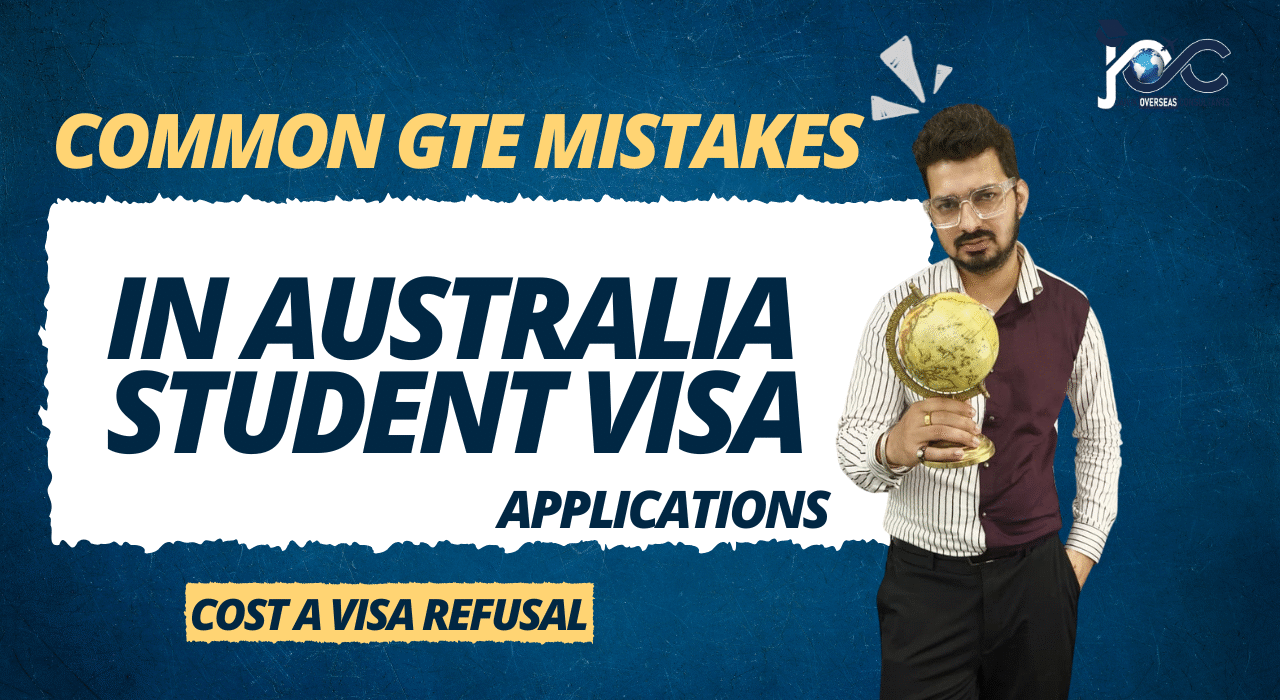For thousands of visionary Indian students, pursuing higher education in Australia is not merely a dream but a groundbreaking milestone. With its globally acclaimed universities, cosmopolitan lifestyle, and abundant career avenues, Australia continues to stand out as a premier study-abroad destination.
Yet, while the opportunity is enticing, the path to securing an Australia student visa can be strenuous. One of the most decisive factors is fulfilling the Genuine Temporary Entrant (GTE) requirement. Every year, countless applications are rejected—not due to lack of merit, but because of avoidable errors in how students present themselves.
In this article, we’ll unpack the Australia student visa GTE requirements, highlight the most frequent pitfalls such as weak statements, course mismatch in Australia student visa applications, and inadequate documentation, and share strategies to present a compelling and credible application.
What Exactly is the GTE Requirement?
The Genuine Temporary Entrant (GTE) requirement is essentially a credibility test. It reassures immigration officers that your primary motive is education and that your stay in Australia will be temporary.
To satisfy the GTE requirement, you must:
-
Exhibit a clear and genuine intention to study in Australia, not migrate permanently.
-
Provide cogent academic and career justifications for your chosen course.
-
Demonstrate robust financial capacity to support both tuition and living expenses.
-
Showcase tangible ties to your home country—such as family, employment, or future prospects—that motivate your return after graduation.
Failure to articulate these convincingly is one of the leading Australia student visa refusal reasons.
The Most Common Mistakes That Jeopardize Applications
1. Submitting a Poorly Crafted GTE Statement
Your GTE statement is the cornerstone of your application, yet many students treat it as an afterthought. Most common GTE statement mistakes weaken the overall credibility of the application.
Typical errors include
-
Copy-pasting from online samples → perceived as inauthentic and easily detected.
-
Providing vague or impersonal narratives that lack individuality.
-
Omitting a strategic explanation of how the course integrates with long-term goals.
-
Neglecting to highlight strong home-country linkages, raising suspicion of migration intent.
Pro tip: Craft a bespoke, articulate, and persuasive GTE statement that reflects your personality, academic aspirations, and future trajectory.
2. Course Mismatch in Application
One of the most glaring issues officers identify is a misalignment between prior academics and the proposed course. This is often referred to as course mismatch in Australia student visa applications, and it suggests a lack of genuine educational intent.
Examples of course mismatch include:
-
An engineering graduate suddenly opting for hospitality without justification.
-
A commerce student attempting to pivot into nursing with no logical bridge.
-
High-performing graduates applying for low-level qualifications.
Pro tip: Ensure your course selection is coherent and justifiable. If you are changing streams, provide a well-reasoned explanation that emphasizes career relevance, industry demand, or personal growth.
3. Inadequate Financial Documentation
Visa officers are meticulous about financial stability. Submitting weak or dubious evidence is one of the primary Australia student visa refusal reasons.
Common mistakes include:
-
Furnishing incomplete or fabricated bank statements.
-
Displaying just enough to cover tuition but neglecting living costs.
-
Relying entirely on loans without demonstrating repayment feasibility.
Pro tip: Present genuine, verifiable, and comprehensive financial records that reflect your preparedness and reliability.
4. Unexplained Academic Gaps or Weak Performance
Academic gaps or consistently poor grades can undermine your credibility as a serious student if left unexplained.
Pro tip: Account for every gap with legitimate reasons—be it professional exposure, internships, skill development, or personal responsibilities. Documentation strengthens your case.
5. Insufficient English Proficiency Evidence
While some institutions may admit students without IELTS or PTE, immigration officers still expect tangible proof of English competence. Fake, outdated, or weak results often trigger immediate suspicion.
6. Overlooking Health and Character Standards
Neglecting to meet Australia’s health and character requirements is another frequent oversight. Missing medical exams, ignoring Overseas Student Health Cover (OSHC), or concealing criminal history can be grounds for outright refusal.
For More Information Watch Now – https://www.youtube.com/shorts/Fkqnh8DThTQ
How to Strengthen Your Application
-
Write a unique, eloquent, and credible GTE statement tailored to your journey.
-
Select a course that is academically logical and professionally relevant, or explain your switch convincingly.
-
Provide authentic financial evidence demonstrating long-term sustainability.
-
Justify any academic breaks with supporting documents.
-
Adhere completely to the English, health, and character criteria.
Many students worry about their score, so we created a full guide on how to get a visa with a low IELTS score.
Read More – https://jaivikoverseasconsultants.com/visa-infographic/
Final Thoughts
Securing an Australian student visa requires more than just academic eligibility—it demands clarity, authenticity, and strategic presentation. Most refusals stem from preventable mistakes such as common GTE statement mistakes, course mismatch in Australia student visa applications, or questionable documentation.
By addressing the Australia student visa GTE requirements thoughtfully and presenting your profile with precision, you can significantly enhance your success rate.
If studying in Australia is your goal, don’t undermine your application with careless errors. Seek expert guidance from Study Abroad Mentor – Gaurav Katyal at Jaivik Overseas Consultants, refine your GTE statement, and position yourself as a genuine, capable, and forward-looking student—ready to seize every opportunity Australia has to offer.
Frequently Asked Questions (FAQs)
1. What are the most common Australia student visa refusal reasons?
The most common Australia student visa refusal reasons include weak or copied GTE statements, insufficient financial proof, course mismatch, unexplained study gaps, and failure to meet health and character requirements.
2. What are common GTE statement mistakes students make?
Common GTE statement mistakes include copying content from the internet, failing to explain future goals, not highlighting ties to the home country, and providing vague or incomplete details about education and career plans.
3. What are the key Australia student visa GTE requirements?
The Australia student visa GTE requirements include proving genuine intent to study temporarily in Australia, explaining the relevance of your course, showing financial capacity, and demonstrating ties to your home country that ensure your return after studies.
4. Why does course mismatch cause Australia student visa refusal?
A course mismatch in Australia student visa applications happens when the chosen course does not align with your academic background or career path. Visa officers see this as a lack of genuine study intent, which often results in refusal.
5. How can Jaivik Overseas Consultants help me with my GTE statement?
At Jaivik Overseas Consultants, under the guidance of Study Abroad Mentor – Gaurav Katyal, students receive personalized support in drafting a strong GTE statement, selecting the right course, and preparing complete visa documentation to avoid refusal.


